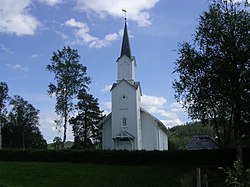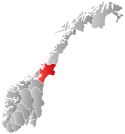Harran Municipality
Harran Municipality
Harran herred | |
|---|---|
 View of the local church | |
 Nord-Trøndelag within Norway | |
 Harran within Nord-Trøndelag | |
| Coordinates: 64°33′40″N 12°29′30″E / 64.5610°N 12.4917°E | |
| Country | Norway |
| County | Nord-Trøndelag |
| District | Namdalen |
| Established | 1 July 1923 |
| • Preceded by | Grong Municipality |
| Disestablished | 1 Jan 1964 |
| • Succeeded by | Grong Municipality |
| Administrative centre | Harran |
| Population (1964) | |
| • Total | 1,085 |
| Demonym | Harrasbygg[1] |
| Time zone | UTC+01:00 (CET) |
| • Summer (DST) | UTC+02:00 (CEST) |
| ISO 3166 code | NO-1741[2] |
Harran is a former municipality in the old Nord-Trøndelag county, Norway. The municipality existed from 1923 until its dissolution in 1964. The municipality was located in the Namdalen valley and it included all of what is now the northern part of the municipality of Grong in Trøndelag county. The administrative centre was the village of Harran where the Harran Church is located.[3]
History
[edit]The municipality of Harran was established on 1 July 1923 when the large municipality of Grong was divided into four smaller municipalities: Grong (population: 1,272), Harran (population: 630), Røyrvik (population: 392), and Namsskogan (population: 469). During the 1960s, there were many municipal mergers across Norway due to the work of the Schei Committee. On 1 January 1964, the neighboring municipalities of Harran (population: 1,085) and Grong (population: 1,962) were merged (back together) to form a new municipality called Grong.[4]
Name
[edit]The origin of the municipal name is uncertain. The area has been known as Harran for quite some time, but the original pronunciation was more like Harrei, so it is possible that the original name was something similar to that. One theory is that the first element comes from the old name for a local river, once known as Herja. The last element may have originally been either eið (which means "isthmus") or ey (which means "island").[5]
Government
[edit]During its existence, this municipality was governed by a municipal council of elected representatives, which in turn elected a mayor.[6]
Municipal council
[edit]The municipal council (Herredsstyre) of Harran was made up of 17 representatives that were elected to four year terms. The party breakdown of the final municipal council was as follows:
| Party name (in Norwegian) | Number of representatives | |
|---|---|---|
| Labour Party (Arbeiderpartiet) | 10 | |
| Joint List(s) of Non-Socialist Parties (Borgerlige Felleslister) | 7 | |
| Total number of members: | 17 | |
| Party name (in Norwegian) | Number of representatives | |
|---|---|---|
| Labour Party (Arbeiderpartiet) | 8 | |
| Joint List(s) of Non-Socialist Parties (Borgerlige Felleslister) | 9 | |
| Total number of members: | 17 | |
| Party name (in Norwegian) | Number of representatives | |
|---|---|---|
| Labour Party (Arbeiderpartiet) | 8 | |
| Farmers' Party (Bondepartiet) | 4 | |
| Liberal Party (Venstre) | 4 | |
| Total number of members: | 16 | |
| Party name (in Norwegian) | Number of representatives | |
|---|---|---|
| Labour Party (Arbeiderpartiet) | 8 | |
| Farmers' Party (Bondepartiet) | 4 | |
| Liberal Party (Venstre) | 4 | |
| Total number of members: | 16 | |
| Party name (in Norwegian) | Number of representatives | |
|---|---|---|
| Labour Party (Arbeiderpartiet) | 9 | |
| Liberal Party (Venstre) | 4 | |
| Joint List(s) of Non-Socialist Parties (Borgerlige Felleslister) | 3 | |
| Total number of members: | 16 | |
| Party name (in Norwegian) | Number of representatives | |
|---|---|---|
| Labour Party (Arbeiderpartiet) | 10 | |
| Joint List(s) of Non-Socialist Parties (Borgerlige Felleslister) | 6 | |
| Total number of members: | 16 | |
| Note: Due to the German occupation of Norway during World War II, no elections were held for new municipal councils until after the war ended in 1945. | ||
Mayors
[edit]See also
[edit]References
[edit]- ^ "Navn på steder og personer: Innbyggjarnamn" (in Norwegian). Språkrådet.
- ^ Bolstad, Erik; Thorsnæs, Geir, eds. (26 January 2023). "Kommunenummer". Store norske leksikon (in Norwegian). Kunnskapsforlaget.
- ^ Thorsnæs, Geir, ed. (2 February 2018). "Harran – tidligere kommune i Nord-Trøndelag". Store norske leksikon (in Norwegian). Kunnskapsforlaget. Retrieved 15 April 2018.
- ^ Jukvam, Dag (1999). "Historisk oversikt over endringer i kommune- og fylkesinndelingen" (PDF) (in Norwegian). Statistisk sentralbyrå.
- ^ Rygh, Oluf (1903). Norske gaardnavne: Nordre Trondhjems amt (in Norwegian) (15 ed.). Kristiania, Norge: W. C. Fabritius & sønners bogtrikkeri. p. 295.
- ^ Hansen, Tore; Vabo, Signy Irene, eds. (20 September 2022). "kommunestyre". Store norske leksikon (in Norwegian). Kunnskapsforlaget. Retrieved 1 January 2023.
- ^ "Kommunevalgene og Ordførervalgene 1959" (PDF) (in Norwegian). Oslo: Statistisk sentralbyrå. 1960. Retrieved 14 April 2020.
- ^ "Kommunevalgene og Ordførervalgene 1955" (PDF) (in Norwegian). Oslo: Statistisk sentralbyrå. 1957. Retrieved 14 April 2020.
- ^ "Kommunevalgene og Ordførervalgene 1951" (PDF) (in Norwegian). Oslo: Statistisk sentralbyrå. 1952. Retrieved 14 April 2020.
- ^ "Kommunevalgene og Ordførervalgene 1947" (PDF) (in Norwegian). Oslo: Statistisk sentralbyrå. 1948. Retrieved 14 April 2020.
- ^ "Kommunevalgene og Ordførervalgene 1945" (PDF) (in Norwegian). Oslo: Statistisk sentralbyrå. 1947. Retrieved 14 April 2020.
- ^ "Kommunevalgene og Ordførervalgene 1937" (PDF) (in Norwegian). Oslo: Statistisk sentralbyrå. 1938. Retrieved 14 April 2020.
- ^ Seem, Anne Marie (1999). Alle disse dager. Grong 1900–2000 (in Norwegian). Grong. ISBN 9788291134321.
{{cite book}}: CS1 maint: location missing publisher (link) - ^ Strand, Jørgen P. (1993). Grong bygdebok. Gårds- og slektshistorie. bd. 1–3. Grong.
{{cite book}}: CS1 maint: location missing publisher (link)

